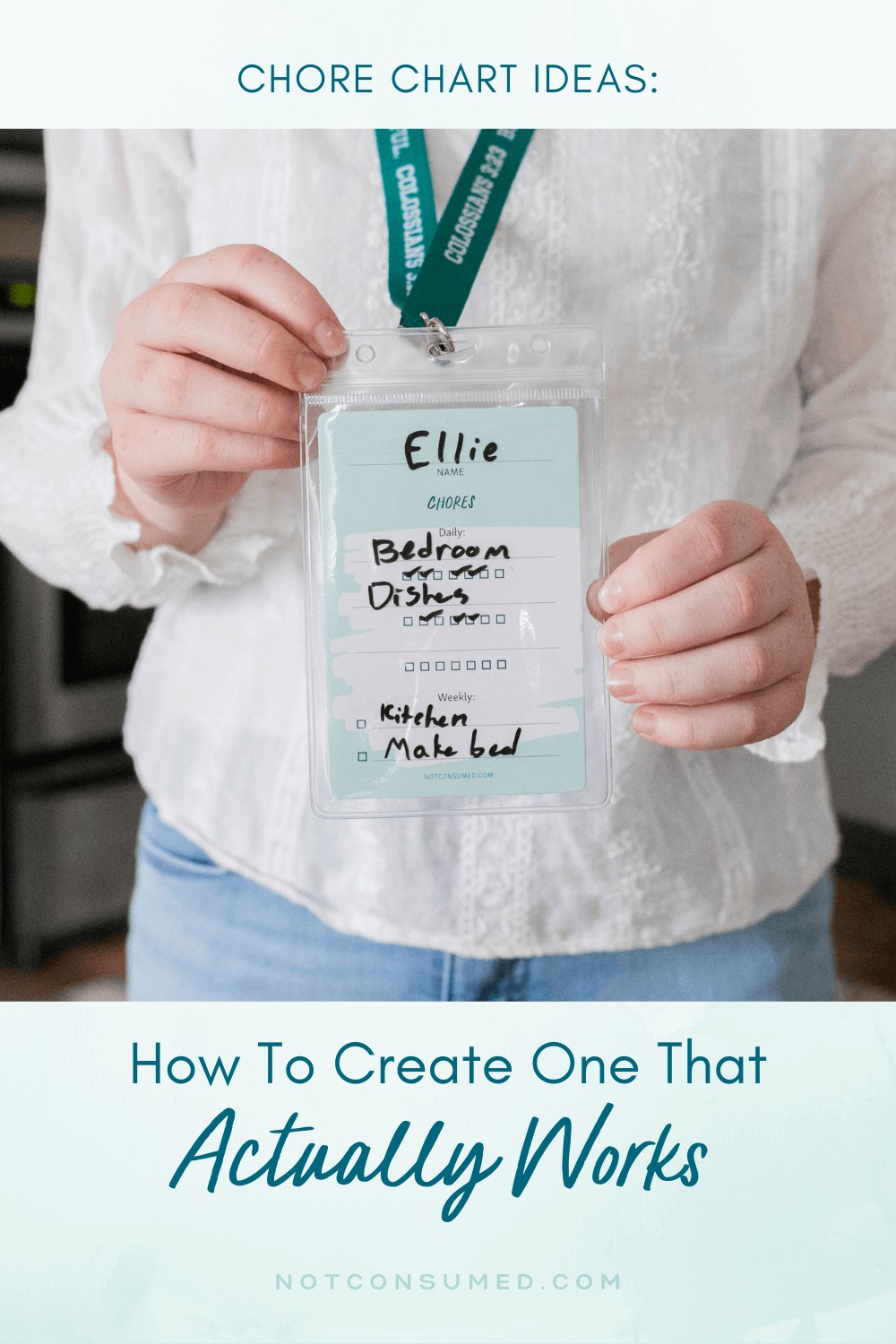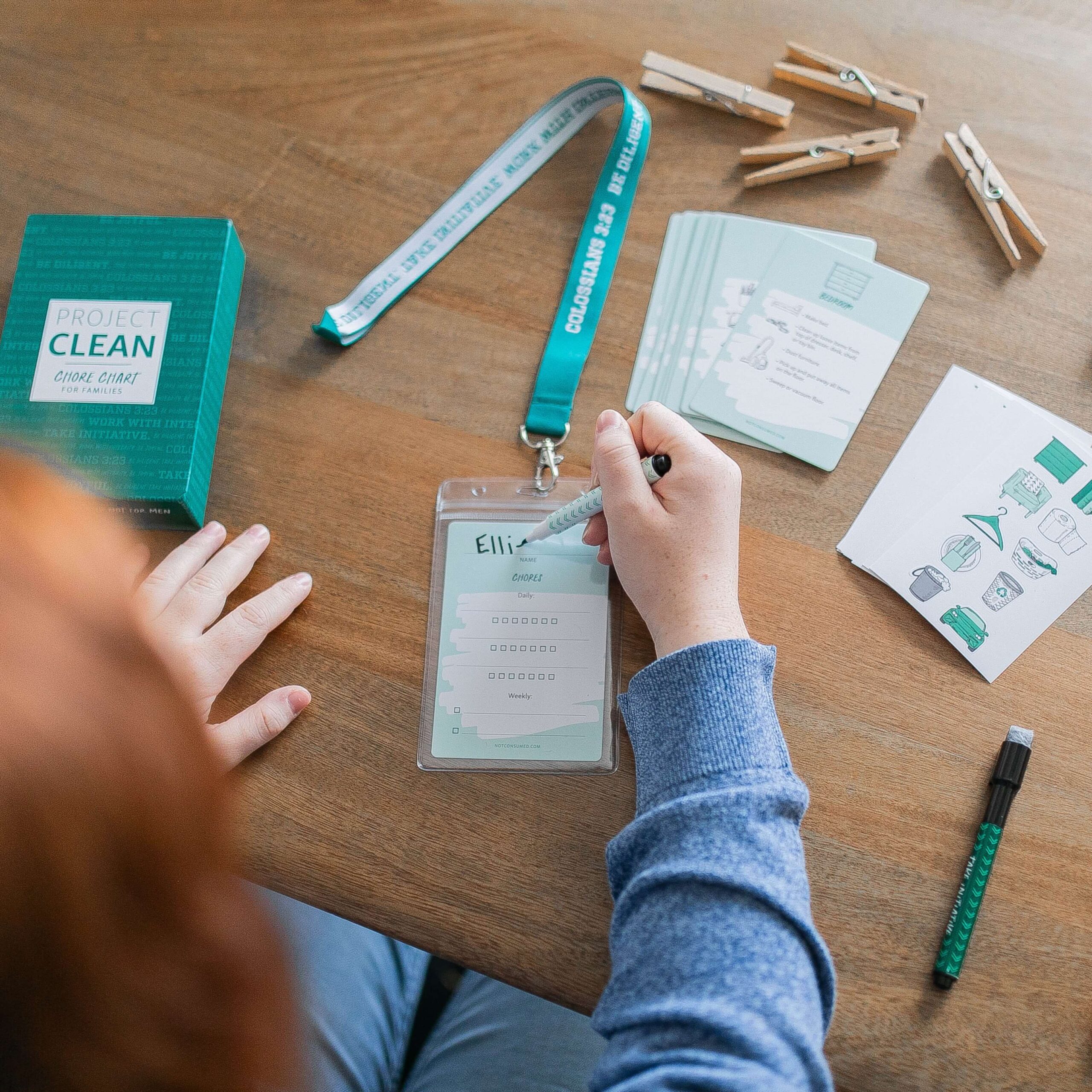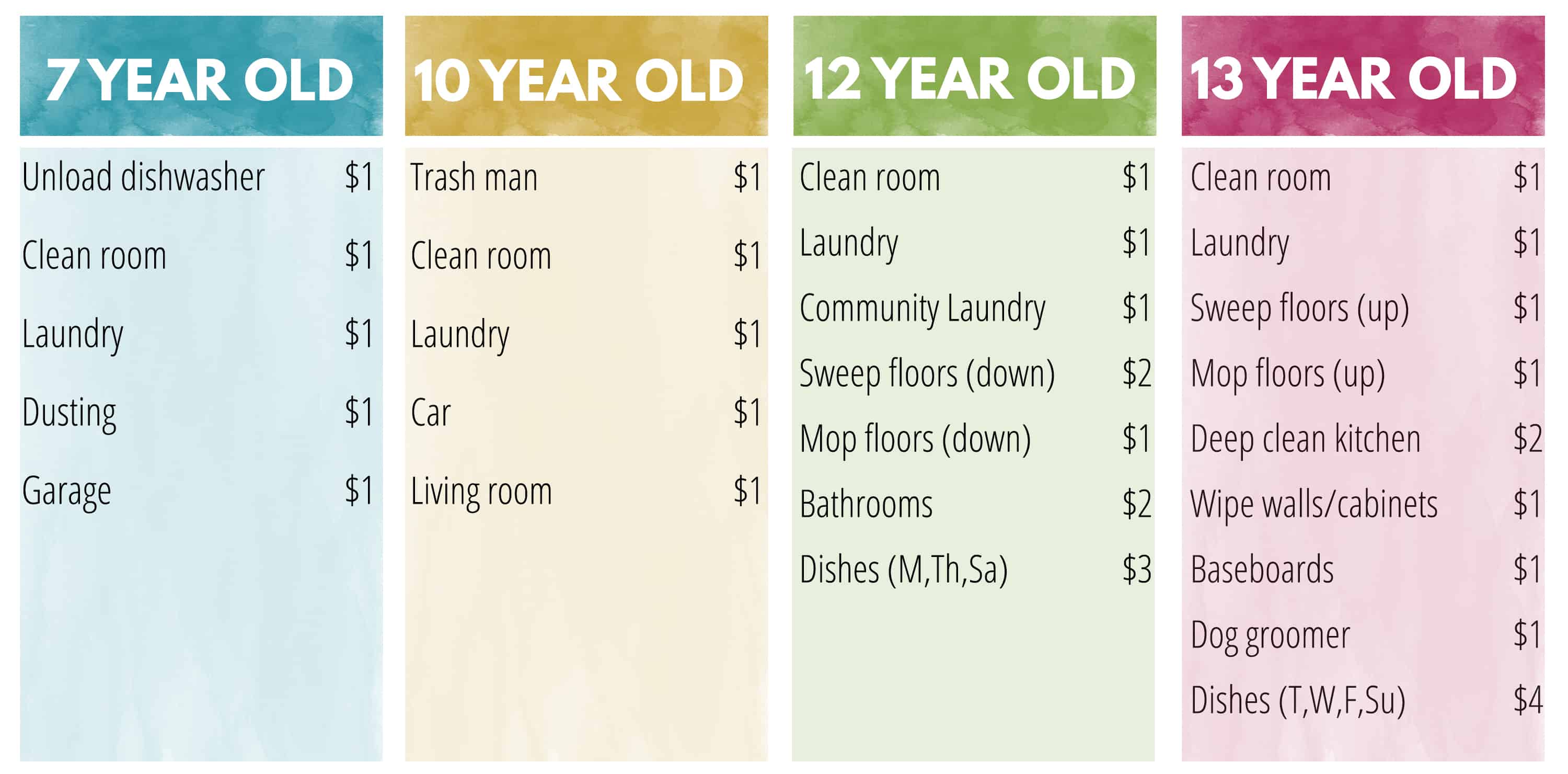Chore Chart Ideas: How to Create One That Actually Works
Learn to create a chore chart that is effective, simple, and motivates kids without nagging. Read more to learn how to create a chore chart that actually works for your kids!
Do you ever feel like the quest for the perfect chore chart is a little like the one Indiana Jones took looking for the Holy Grail? Ha ha. Okay, maybe it’s not that bad, but it sure is frustrating. It’s so frustrating that many parents just throw their hands up.
We want a chore chart that:
- motivates kids without nagging
- is fun and engaging no matter how old you are
- is simple to use
- works for various ages and numbers of kids
- doesn’t take much management from parents
- teaches good money habits without entitlement
Is that too much to ask for? You might think so, but no. It’s totally possible to put something together that meets ALL those requirements, and I can’t wait to show you how!

Table of Contents
Why I Was So Desperate for Better Chore Chart Ideas
All the things on the list above were important to me, but the motivation and management aspect of chores was a huge part. My kids had a hard time understanding the importance of taking care of their things and our home. It felt like I was always reminding them to clean up their messes, and they weren’t even getting to regular chores like dusting or taking out the trash. So much of my time was spent following after them and making sure their work was actually getting done. It wasn’t sustainable, and I knew something had to change!
In addition to those problems, I knew I needed to teach good money habits to my kids. 8 out of 10 Americans are in debt, and I had worked hard to get out of my college and credit card debt. I didn’t want my kids to fall into the same traps I had when I was younger. The trouble is, you can’t teach kids to manage money without giving them money to manage. I don’t want to pay my kids an “allowance” just for honoring me with their presence.
I needed better chore chart ideas to help me teach money habits and home management habits!
The Inspiration for My Chore Chart Idea
Then I read Smart Money Smart Kids. I must admit that I love Dave Ramsey. His money principles were largely responsible for helping me dig out of debt. This book, co-authored by his daughter, was a game-changer.
Using what Dave taught me, I came up with a totally new chore chart idea that teaches good money habits. I was thrilled when the book addressed the age-old problem of “to pay or not to pay” for chores. Finally! A solution to my struggle. Here’s the secret: some chores are done because you live here, and some are done to teach you to manage money.

Brilliant, right? You do have responsibilities for living here, and no, I’m not paying you an “allowance.” However, I am willing to pay you for work above and beyond those normal responsibilities. Using this foundation and a few other parenting strategies I love, I came up with a brand new chore system we’ve been testing for the last year. I think it’s safe to say the jury is in. It works!
My oldest paid for several camps this summer. All my kids have had the opportunity to donate to hurricane relief funds, buy gifts for their youth pastor who is leaving, and of course, give a regular tithe. Oh, and the grocery store trip is bliss. They know they have to bring the money if they want something not on my list. Now they are empowered to do just that instead of being frustrated with the constant “no.”
How to Create a Chore Chart That Works for Your Family
Step 1: Have a family meeting to establish your chore chart ideas.
I called a family meeting (something we started after I read another great book, 7 Habits of Highly Effective Families). During the meeting, I taught my kids a few foundational things about money from Dave and Rachel’s book. Most importantly, the Sorgius family doesn’t do debt. (That means no, I won’t let you borrow money to buy gum even if you can pay me when we get home.) I realized this one bad habit was teaching very bad principles about money to my kids— not only about debt but about compulsive “gotta have it now” spending.
We also talked about the importance of working hard and how everyone has to earn money to buy things—laying the foundation for my chore chart idea. (I’ve recently been supporting this discussion with my new Bible study, Work Unto the Lord.)
It is part of our Heart Series, designed to teach your kids Biblical principles showing how abiding in God’s truth will change their hearts and help them grow. Each bundle contains five age-appropriate Bible studies: Fruit of the Tongue, Keep Thy Heart, Do Right, A Content Heart, and Work Unto the Lord—plus, some fun bonus items!
Step 2: Make a list of work that needs to be done.
As we concluded our family meeting, I told the kids to be thinking about all the work needed around the house because I would be asking again in a few days. When we had another opportunity for a family meeting, we sat down and made a huge list of work (we used this paper). This included everything that EVER needed to be done around the house (inside and out). Everyone contributed things they knew were messy or needed attention.
When the listing got slow, I put it down for the day. Each morning for the next week or so, when we came to the table for family devotions, I asked if anyone had thought of additional things for the list, and we added a few over the course of the week.
Step 3: Determine frequency and workload.
As a general rule, the chore chart idea that Dave suggests is giving kids 1–5 jobs to start with and letting them grow to 10 or so. Of course, this will vary greatly depending on how old your kids are. My 6-year-old got 5 jobs right away because he’s been doing chores for years now. My 9-year-old stuck with 5 jobs because I didn’t feel he was ready to tackle more. The teens got 10 each. This worked really well for us, but I’d suggest easing into this kind of schedule if your kids aren’t used to chores.
The other question we faced was frequency. Some chores need to be done daily, like tidying your room and making your bed (also things like loading the dishwasher or sweeping the kitchen). To make this easier, we gave bigger jobs (like sweeping the floors every day or doing the dishes) a better paycheck. Some smaller things, like daily tidying your room, were not given a higher pay because some of that really should happen simply because it’s your space.
I sat down and thought through some of these things before I called the next family meeting so we would be ready to assign jobs.

Step 4: Have an employment day.
Finally, the big day came, and we called another family meeting. I brought out the giant list, and we visited it again. I asked for any late entries, and then we counted all the jobs. THIS WAS THE MOST POWERFUL PART. When we got the number, the children were shocked. “Who has been doing all of these jobs?” they gasped.
I couldn’t have asked for a better response from them! In fact, that’s exactly what I wanted them to see. One person couldn’t possibly get all of this done, and that was clear to them. (Score one for Mom!)
The next step for this chore chart idea was to start dividing tasks. First, we made a list of things we thought everyone should do as a part of living here. These are jobs you don’t get paid for but are expected to do. Most of them are things that are difficult to assign to others, such as clearing your plate from the table and putting it in the dishwasher. Also included are picking up your own things from all rooms of the house, helping with groceries, and helping with meals.
With those off the list, I then let the children “apply” for various jobs. They had to state why they thought that was a good fit for them or why they liked it. Everyone really enjoyed this. The youngest got to pick first (so we could make sure some of the easier tasks were given to him). Next was his brother. Finally, my teenage girls took turns picking one job at a time.
Below is what we came up with. Remember, this is just a reference. Your needs and kids will be different!

Step 5: Consistently expect work to be done, and pay accordingly.
Probably the most important step with this chore chart idea is setting the standard. With every single chore, TEACH your child the proper way to do it. In our Project Clean Chore Pack, we include instructions and standards for each chore, so that there’s no question about how a job should be completed. These instructions are illustrated cards that fit inside a lanyard, making it easy to learn and track chores at any age, so even your six-year-old can stay on top of things!
The key to making this system work is consistency. If the kids do the work and don’t get paid because you forget all the time, it’s not going to work. Granted, there’s always grace, so be sure to give that to yourself. But be more consistent than graceful, okay?
We do chores on Friday. It’s our best day logistically. From time to time, it slips into the weekend. All chores that are done weekly are completed that day. Then they bring their sheets to me for payday. This is important— I actually get up and walk around the house to inspect their work.
Most chores are worth $1. If completed to my specifications, that will be given. If not, I have the child correct the mistakes, but I deduct a fee for re-training, usually $.25 to $.50. We tally up how much they earned and then divide it into 3 categories: save, share, and spend. My boys put $2 in save and share, with $1 in spend. This is intentional to teach them first to focus on others and the future, and lastly to focus on that pack of gum. The girls have a similar percentage they follow.

If they lose money for a chore not done or not completed properly, they must still divide their total in the designated order: share, save, THEN spend. This keeps them from being able to spend when they aren’t doing all of the work. It also keeps me from having to deal with a bunch of loose change.
A few miscellaneous rules we make about chores:
- You cannot work on paid chores if your responsibilities (chores you do because you live here) are not done.
- School is also a priority and cannot be neglected for work.
- If you cannot get to your chore because of the above rules or because you simply neglect it, Mom reserves the right to offer it to someone else and pay them instead.
- If one of your siblings is sick (or if you just feel like it), you can SERVE them by doing their chores for them. We don’t get paid for serving others. It’s a gift. (Need some ways to help your child serve others? Becoming a Servant is a family Bible study focused on Jesus’ call for every Christian to serve.)
Again, I really recommend you read Smart Money Smart Kids. This post has given you a glimpse into how I set up my system and will hopefully create chore chart ideas for you, but for maximum effect, you need to learn the foundations your kids should know. You will learn the many ways you can influence your children negatively and positively through the process.
How This Chore Chart Idea Will Actually SAVE You Money
You know how sometimes it feels easier just to complete the chore yourself rather than chase down one of your kids to do it, and then do it a second time correctly? I certainly do. It took some time and work to get my kids started on our chore chart, and it took effort to make sure they learned how to do each chore properly.
But then they knew exactly what was expected of them. They knew the standard I was holding them to, and there wasn’t any confusion about who needed to do what. My kids were learning to take personal responsibility for the house, and I was suddenly far less frustrated because I could rely on them to actually do the chores assigned to them.
Not only that, but my kids learned the value of money. They went from asking me to buy them everything in the store to saving up their money and making a plan for purchases.

Yes, it’s expensive to pay for chores like this. For me, it ranges from about $30-$50 per week because I also allow them to pick up extra chores on things that don’t get done regularly or aren’t assigned (like pulling weeds, raking leaves, deep cleaning the inside of the fridge, etc.).
Just remember one thing. This isn’t money you are losing or spending. It’s money you are delegating to a specific purpose.
And once they realized they were responsible for financing their own things like trendy clothes or an ice cream cone, my kids raced to pick up extra jobs around the house to earn money. It was the same for things like summer camps and extracurricular activities too. It’s money I probably would have GIVEN them before. But now they are learning to make wise choices, manage their money, and save for big things—something most adults can’t even do!
Project Clean Chore Chart Pack
I’ve created a super fun version of our chore chart that helps teach responsibility and good money habits. Our Project Clean Chore Chart Pack was created to provide an organized and effective method for you to teach your kids the life-skill of caring for their home. This system is simple, easy to use, consistent, and motivating! Each chore pack provides a child with their own lanyard, badge, and chore cards to keep track of their personal chores and the progress that they make. Chores in each “zone” are explained so that kids understand what is expected of them, including specific step-by-step instructions.
Plus, there is a fun award sticker chart for when they “master” a skill! Using the included wet erase markers makes this system customizable and reusable. This system will encourage your kids to become independent and more responsible so that you can spend less time nagging them and more time helping them cultivate life skills.

More Resources
August 2023—Editor’s Note: This post was originally published in October 2019 and has been revised and updated.

Through practical tools & Bible-based resources, Kim Sorgius is dedicated to helping your family GROW in faith so you can be Not Consumed by life’s struggles. Author of popular kid’s devotional Bible studies and practical homeschooling tools, Kim has a master’s degree in education and curriculum design coupled with over 2 decades of experience working with kids and teens. Above all, her most treasured job is mother and homeschool teacher of four amazing kiddos.












Love this! This is a great system! I love Dave Ramsey, but the system never touched all of the this I wanted to touch on. I like how you incorporated serving others, neglect of chores, saving for summer camps, or even clothes. Thank you for telling is about your journey.
Have you read Smart Money, Smart Kids? I don’t think it covers all of those things, but it is more specific for child training than his other books.
This is perfect! I did read Dave Ramsey’s Smart Kids book earlier this year, and I love this. What jobs did your family decide were the ones that did not get paid that they were just part of being in the family? That is what I am trying to decide for our family. I have 4 kids and would love to give them a dollar for each job, but we are trying to get out of our debt, so I might have to decrease our amounts some.
These are our “because you live here” chores: picking up your own things around the house, helping with grocery shopping/unloading, helping with preparation of meals (older girls prepare meals on their own one night a week, plus make all lunches), making your bed everyday, etc.
Remember with the monetary part to include your budget for necessary items, like clothes. This helped me to be able to fund all 4 kids at $1 per task. We actually have a few that are worth $2 because of the time it takes to complete!
Thank you! I signed up with my email to get the package with the chore charts. Was that all I had to do?
I have still not received it in my email, that’s why I was asking. 🙂 Thanks!
Love this. We have read the Smart kids book as well. The remembering to pay part was difficult, so bringing us the completed form each week and asking to check the work and get paid being their responsibility helps. We used to be asked for several weeks worth of paydays at the store when someone wanted to buy something.
Effective. I like how it makes it easier to teach kiddos the cost of buying things -> is that [gum/toy/chips/…] worth the amount of work you need to do to have enough spending cash to purchase it.
My older sister taught me that when I was a kid (she is ~8yrs older) she was shocked to see that grabbing some fries to eat when out translated to her hours at work to pay for it was way more of her time then she felt was worth it. Her upset stuck with me (I was about 8 at the time, and 30 yrs later it still sticks ?)
Thank you! I signed up with my email to get the package with the chore charts. Was that all I had to do?
Yes, that is all you need to do. You should receive a download with the printable chore charts included. If for some reason you do not receive that, please email kim@notconsumed and we will figure out the problem. 🙂
Suzanne
Not Consumed customer service
Thanks so much for all you do! I LOVE just about everything you put out. It’s like you make the things in my head tangible. I praise God for you. I was just talking to my brother in law about this same type of system and he liked what I was saying. Now I’m going to email this to him so it will be clearer. Thank you again.
I LOVE this. I have read Dave Ramsey’s book that you mentioned and gained a lot from it but my oldest is 5 and the traditional chore chart just isn’t working with her. Thank you for sharing how you have incorporated this in your home… I learned new ideas to try with my girls!
I’m currently reading Dave’s Smart Kids book…and so far my kids are loving the system. We did add a few elements to help with since our kids are all under 7. Because they are so little I pay them as soon as possible after their job is done and they keep all their money in their cup at our command center. I pay them using our math money (play money that’s simply colored/drawn up more accurately) and every Friday they count it up and divide it as desired. Then during nap time I set up the “mommy dollars store” for them to shop at. It’s full of random toys I pick up($1store, clearance racks etc) and I purposely price some items so that the kids need to save up a week. (I try to only make them wait the extra week so they don’t get discouraged.) The second element I added was game tokens. You can do extra jobs or if I catch good behavior to reward you get game tokens that are each worth five minutes of play. (On Fridays they’re also buyable) it really motivates my older boy who turns them over to daddy to get some video game time.
I think this may work for us! Using play money. I can’t every week pay real money.. but my kids would definitely love a store they could shop from.
This is genius!!!!
I LOVE this! It’s just what I’ve been thinking of, but not sure how to implement. Thanks for all of the information!
Wonderful and so thorough! I love the fact that you have them apply for jobs — what a great way to engage them. Thanks for sharing this!
Love this so much!
Kim, I just downloaded your Ultimate-Family-Discipleship-Collection. I am looking forward to diving in. You are a blessing and I appreciate your generosity. Thanks a lot.
Thank you for this. I have been wanting to implement a paid chore system to teach my 7 yr old about saving, spending and tithing, and your printable chore cards look perfect. I also appreciate the reminder that if we want the kids to be consistent about doing the chores we have to be consistent about paying and checking their work. I remember being really excited as a kid when my parents started a paid chore system (on top of the many chores we had to do because we lived there), and then being disappointed when the idea just sort of fizzled. (of course the unpaid chores marched on 🙂 ) Your testimony and the resources you have created are a huge blessing to me. Thank you
This is such a wonderful post – thank you! I have a few questions I’m hoping you can answer…Taking your example, do you pay $1 for each time a daily chore is done – or $1 for doing them all week?
Also, how did you go about figuring the amount? (I know you said you took into account what you normally spend on that child per year, but did you figure in the whole amount for all things – clothes, camp, treats, etc. Or did you take a percentage of that amount so the kids would need to prioritize? Are there certain activities/items you still pay for once you implemented this system or do the kids pay for everything?) Are details like this addressed in the Smart Kids book? Thank you so much!!
The book definitely has lots of ideas on these topics. I pay $1 per week for a chore. However if the chore has to be done daily, it might be worth more. Most of our daily chores are UNPAID chores (like making the bed). For camps and such I actually have a matching program. Dave teaches this, too. If they save $100, I’ll match $100.
What is the share money used for. Thank you for this post! I’m so excited to implement it!!
Help with printing…..
Thank you Kim for putting this all together, we’ve been planning on how to make out days run smoother instead of me assigning chores and kids complaining. I just had one issue. I tried several times but didn’t get an email with the printable chore cards. And I’m not creative so this is a must! Thank you!
Hi Jenelle, I have signed you up for those. If you don’t see them, please email joy@notconsumed.com.
Thank you for your generosity and for sharing your wisdom. With 4 kids ages 2-10, it has been difficult for me find something that works and sticks –this looks very promising!!
I really love this idea and the house zoning approach. Do you currently do both?? I was trying to figure out a way to do both. A zone and a paid system. I just ordered the Dave Ramsey book too! We’ve talked about a paid system before and even tried but I was not consistent with paying because I never had cash and didn’t know what to do with when they said it was done but it wasn’t done to my standards. Any experience with neurodiverse children and the chore charts or family chores?
Thanks for all your amazing resources and support!
I have not done both. But I think you could come up with a way. Perhaps zone and then special chores they can pick up for money?
Nice post
Hi, I ordered the chore chart and hope to start making a list of chores with the kids soon. I have a totally random question. You said your oldest saved up for camps, I want my daughter to do that to. So they save money in their save jar for camp? Or does the save jar go in the bank, and they save their spend jar to spend on going to camp?